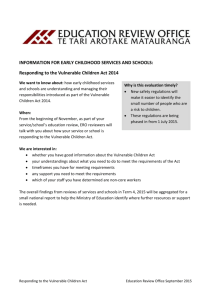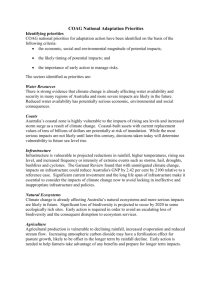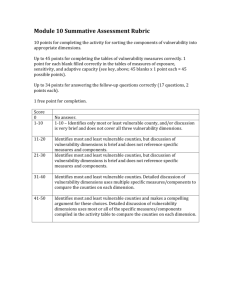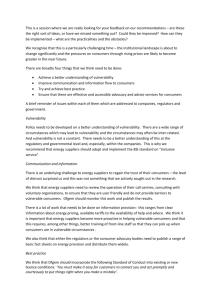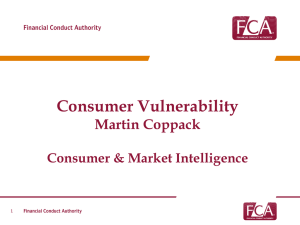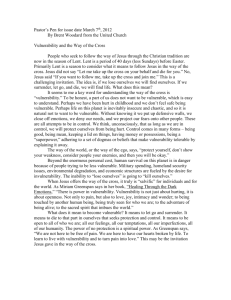`Consumer Voice and Representation`:
advertisement
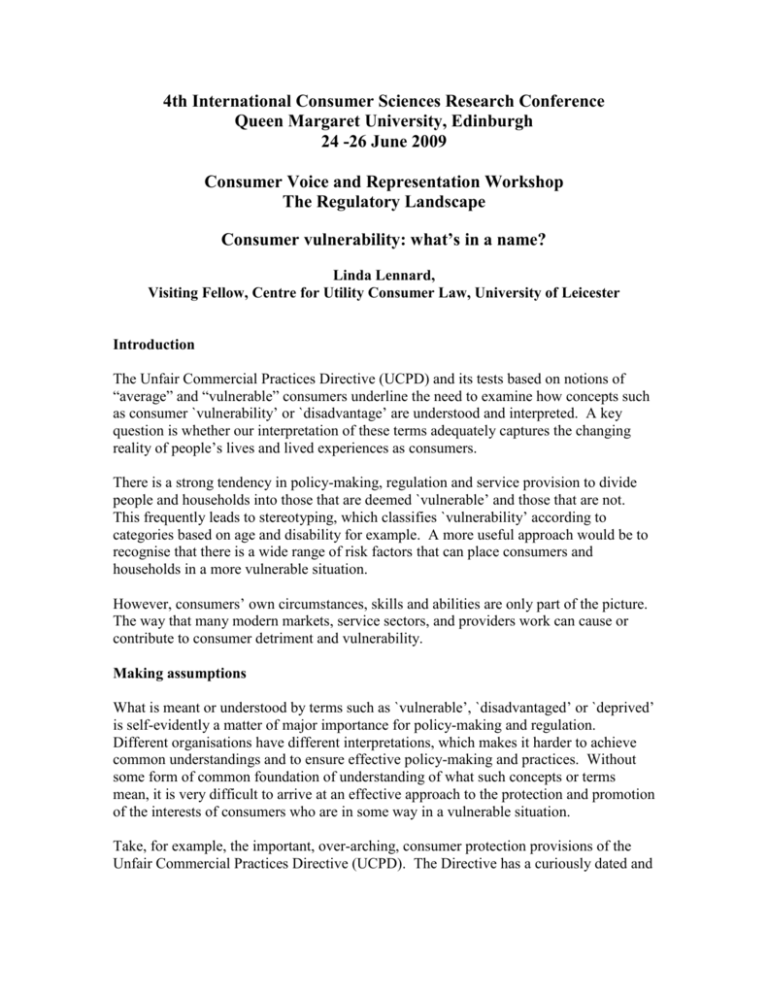
4th International Consumer Sciences Research Conference Queen Margaret University, Edinburgh 24 -26 June 2009 Consumer Voice and Representation Workshop The Regulatory Landscape Consumer vulnerability: what’s in a name? Linda Lennard, Visiting Fellow, Centre for Utility Consumer Law, University of Leicester Introduction The Unfair Commercial Practices Directive (UCPD) and its tests based on notions of “average” and “vulnerable” consumers underline the need to examine how concepts such as consumer `vulnerability’ or `disadvantage’ are understood and interpreted. A key question is whether our interpretation of these terms adequately captures the changing reality of people’s lives and lived experiences as consumers. There is a strong tendency in policy-making, regulation and service provision to divide people and households into those that are deemed `vulnerable’ and those that are not. This frequently leads to stereotyping, which classifies `vulnerability’ according to categories based on age and disability for example. A more useful approach would be to recognise that there is a wide range of risk factors that can place consumers and households in a more vulnerable situation. However, consumers’ own circumstances, skills and abilities are only part of the picture. The way that many modern markets, service sectors, and providers work can cause or contribute to consumer detriment and vulnerability. Making assumptions What is meant or understood by terms such as `vulnerable’, `disadvantaged’ or `deprived’ is self-evidently a matter of major importance for policy-making and regulation. Different organisations have different interpretations, which makes it harder to achieve common understandings and to ensure effective policy-making and practices. Without some form of common foundation of understanding of what such concepts or terms mean, it is very difficult to arrive at an effective approach to the protection and promotion of the interests of consumers who are in some way in a vulnerable situation. Take, for example, the important, over-arching, consumer protection provisions of the Unfair Commercial Practices Directive (UCPD). The Directive has a curiously dated and unclear interpretation of what constitutes a `vulnerable consumer’, namely that this consists of `mental or physical infirmity, age or credulity’. In practice the potential scope of ‘mental infirmity’ is enormous and amorphous, covering anything from a severe mental illness to a mild to moderate learning disability; it could include a temporary cognitive impairment resulting from a stroke or accident, a complex phobia, or depression following a life event such as bereavement. Similarly, physical infirmity could potentially cover anything from moderate hearing loss to a serious and life-threatening illness, to a temporary though restricting event such as a broken limb. As for ‘age’, there is a very substantial evidence base demonstrating that in and of itself a consumer’s age may not be a significant determining factor of the degree of risk of disadvantage. On the contrary, for example, as a result of life experiences, older people may be more resilient and resourceful than others in coping at times of stress. At the same time it is also important to understand that there are likely to be distinctions in terms of the risk of vulnerability between `older older’ and `younger older’ people. For example, almost half of those aged 75 or and over report a long-standing illness or disability. The ‘concept’ of credulity is confusing as it is subject to different interpretations and it is highly questionable whether its inclusion is particularly useful. Draft OFT guidance on the UCPD simply states that credulity “covers groups of consumers who may more readily believe specific claims”. In the real world, an ‘average’ household might exhibit what some might regard as credulity at a time of stress, for example the sudden and unexpected loss of employment income could render them much more susceptible than previously to certain refinancing ‘deals’ (which may not be in their medium to long term interests). Although credulity might be understood in some cases as related to consumers’ circumstances and abilities, it could also arise because of the specific nature of a retail or marketing practice. For instance, would ‘credulity’ apply in the case of customers who agree to pay for an expensive, and most likely unnecessary, extended warranty on a washing machine or DVD player? The UCPD’s approach seems to be based on the misleading assumption that there is a relatively fixed population of `vulnerable or disadvantaged consumers’, which, whilst this may reflect the circumstances of some consumers, fails to capture both objective and perceived realities. The duties of a number of regulators to have regard to the needs of particular `groups’ of consumers, such as disabled people and older people, also appear to be based on the assumption that it is possible to define consumers according to somewhat static and narrow categories. But life is frequently not like that. Almost anyone can be placed in a vulnerable situation, and be more at risk, because of changes in their circumstances, such as the sudden loss of a job, the onset of illness, disability or mental health problems, or through having to assume major caring responsibilities. Others may be ‘just about’ coping but an unexpected change in their circumstances could lead to serious problems or even a crisis. 2 Many factors can determine how resilient someone is in dealing with such events, including the ability to accept and adapt to change, financial and emotional resources, and the availability of good advice or support. With some exceptions, socio-economic deprivation can occur almost anywhere, sometimes suddenly or unexpectedly, sometimes on a long term basis, and in areas which may otherwise have been relatively prosperous. Some consumers on low incomes may feel and appear to ‘cope’ well, whereas others – including households which are used to relatively high incomes – may have very little resilience and may be at considerable risk following a life event such as loss of employment. In parallel, an approach to consumer vulnerability which relies on narrow categorisation may have little relationship to the degree or type of harm or detriment which the consumer actually experiences. Another danger of this, commonly-applied, approach is that it can fail to capture or reflect the episodic or fluctuating nature of many conditions or problems. Looking at risk factors instead An approach that is based on looking at `risk factors’ is likely to be more useful in helping to understand and address the needs of consumers in vulnerable circumstances. The risk factor approach acknowledges the evidence that factors such as physical disability or low income may well put a consumer at a disadvantage in relation to many markets. However, it can also acknowledge that consumers whose circumstances give rise to particular risk factors may not have identical needs or levels of resilience. A risk factor approach can help policymakers, regulators and providers to appreciate more the number of consumers who may be being put at a disadvantage, and to develop a better understanding of their needs and circumstances. We have elsewhere attempted to define and delineate common risk factors, and have discussed their possible relationship to the likelihood of consumers being put at a disadvantage1. However some of the key factors are outlined below: Age and risk factors such as poor health, disability, or other potential forms of vulnerability are correlated with being older: a third of people aged 65 to 74 and almost half of those aged 75 or over report a long-standing illness or disability. Older people form the majority of those who are registered as blind or partially sighted and of those with hearing impairments. Many modern market ‘interfaces’ more or less demand of the consumer that they are able to interact in particular ways, and this may not be possible or easy for some older consumers in these circumstances. Physical disabilities, including sensory impairments and learning disabilities, are often correlated with low disposable incomes (for instance, as a result of discrimination in labour markets, and the additional costs of disability). Disabling societies such as that in 1 At a Disadvantage: Discussion Paper, George M and Lennard L, Centre for Utility Consumer Law, University of Leicester, 2006. 3 the UK may for instance make it practically much harder for those with mobility problems to ‘shop around’ (by no means all shopping can be arranged via the phone or the Internet – and well over a third of households do not have Internet access anyway); consumers with arthritis (about 9 million people) may find it difficult to be able to ‘key in’ fast enough or accurately enough to interact with a bank’s automated telephone tree system. Estimates of the total number of adults and children with a disability range from ten to 13 million, and this includes a host of, often-overlooked, conditions such as - at least 400,000 people with significant disfigurements or scars, often making people feel uncomfortable in social situations; 10% of people have some degree of dyslexia (2% are affected seriously); and 7%-8% of the population experience incontinence. Other conditions or circumstances which are often overlooked include the one millionplus people each year who attend hospital as a result of an acquired brain injury, of which 100,000 every year are left with a significant disability: there are many other causes of cognitive (and often emotional) impairment, such as dementias and the side effects of some medications. Obviously there is a wide range of potential consequences for consumers experiencing such problems in dealing with everyday life. Every year about one in four people experience some form of mental health problem. Depression and anxiety states are the most common – affecting over 2.5 million people which may be long term, episodic, or short term – and disorders like obsessive compulsive disorder and phobias are the next most common. Many consumers are likely to be at a higher risk of being put at a disadvantage if they are living on a low income (and especially if they have little no savings); choice may be limited, they may be paying more for products or services – for example, through having to use pre-payment meters for fuel supplies, or being unable to pay for goods or services by direct debit. For example over 6 million people have major caring responsibilities for a relative, friend or partner, and carers are more likely to face risks of financial difficulties and poor health. Other risk factors include homelessness, having low basic skills, and living in a rural area, especially if you do not have easy access to shops and services. Among other risk factors should be included the position of some, mainly but not exclusively older, consumers whose previous life experiences have not equipped them to engage effectively with the complexities of many modern markets. For example, some feel unable to understand or use ICT products and services; whether or not this is ‘objectively’ true, there is the danger of disengagement, exclusion, and a corrosion of self-confidence and self-esteem. Another danger of the categorisation approach to consumer vulnerability is that it frequently fails to capture the fact that many people have a number or cluster of risk factors. Research by the then Department for Constitutional Affairs in 2006 concluded that: ‘Over four million people each year have at least one serious problem, but the 4 people most at risk of developing clusters of problems are: victims of assault; lone parents; unemployed people; those living in high density housing; those on benefits; people with disabilities, and people who are physically and mentally ill.’ 2 The report added: ‘Not only are these people most at risk of developing a number of problems, but they are also the least likely to be able to deal with them. This is often a result of their inability to cope, combined with a poor support network, making them unable to interact effectively with people and services’. The role of providers Terms like ` vulnerable consumers’ can imply that vulnerability or disadvantage is all or mainly down to consumers’ own circumstances and abilities. However, another key aspect is the role of providers. The actions or inactions of markets and providers (public providers as well as those in private sectors) can put almost anyone at a disadvantage. The consequences for consumers range from ‘wasted’ time, energy and effort to confusion, stress, barriers and extra costs in accessing services and goods, and potentially risks to health, safety and well-being. The consequences may well be more severe for some consumers either in general or at particular times because of their personal circumstances. An Office of Fair Trading report on consumer detriment in 2008 found that 32% of the representative survey sample of over 10,000 people had experienced one or more problems over the previous 12 months.3 Of these, almost half had experienced more than one problem. The main types of problem in order of prevalence were: poor service quality; defective goods; delivery/collection/repair problems; prices; problems with retailers, and misleading or incorrect information. The direct costs of experiencing these problems were estimated at just over £249 per problem (equivalent to £6.6 billion to the UK economy over 12 months). Respondents also reported other costs such as the amount of their time it took to try to resolve the problem. There were psychological effects as well, with stress, anger and worry being more pronounced among those on lower incomes. To ground these sorts of findings in the ‘everyday’ of consumers’ experiences, outlined below are some examples of how consumers can be put at a disadvantage by providers in private and public sectors4: 2 Getting earlier, better advice to vulnerable people, Department for Constitutional Affairs, 2006. 3 Consumer detriment: Assessing the frequency and impact of consumer problems with goods and services, Office of Fair Trading, 2008. 4 Consumer Disadvantage: the role of providers, George M and Lennard L, National Consumer Council, 2008. 5 The ways in which we have to inter-act and communicate with providers have changed significantly compared to previous generations. For instance, whilst many consumers in vulnerable circumstances frequently prefer face-to-face contact with service providers, this may well not be available. Some consumers are likely to be disadvantaged if they find it difficult to negotiate their way through an automated call centre or are unable speak to someone directly who will take responsibility for their problem. It takes little imagination to understand that this may present a serious barrier (potentially with serious consequences) for someone with learning difficulties or who is suffering from stress or an anxiety disorder, for example. It can also be very costly for people on low incomes using pay-as-you go mobile phones to spend a lot of time stuck in an automated telephone system. A call centre system based on rigid scripts and procedures can present significant barriers to any consumer but the effects are likely to be more acute if someone is in a vulnerable situation because of individual circumstances or a sudden crisis. Many people who experience risk factors, such as disability or sensory impairment, have developed very effective strategies for coping well with all manner of public and private providers but are put in a vulnerable position because of the ways in which providers operate: for example if people with sight or fine motor problems have to use touch tone phone or screen-based interfaces, or if those with speech difficulties are faced with automated voice recognition call centres. The various numbers and passwords that are now required in order to undertake many transactions can be daunting for any of us but particularly so for the many people who may can find it particularly difficult to remember these numbers, for instance because of cognitive impairments or simply having basic literacy and/or numeracy difficulties. A large and sudden hike in prices of essential services is likely to bear more heavily on those on low incomes but can also affect other consumers who may be struggling to meet current financial obligations. Many consumers may be in a disadvantaged position because of a restricted choice of retail outlets in many areas as well as Post Offices, bank branches and cash machines, especially if they have mobility problems and/or are on low incomes. Much is made of increased consumer choice nowadays but choice can disappear into the ether when consumers try to exercise it. For instance, customers can be locked into long contracts for financial services or communications packages and subject to financial penalties if they try to switch. In the communications market, the tendency of providers to bundle services together may offer a good deal – or not: it is often very difficult to tell either way because of problems in making easy comparisons between bundles and offers. And then, `loyal customers’ can be disadvantaged and effectively penalised financially if they are not able to access cheaper services that are offered to new customers, or if they are unable or unwilling to keep switching suppliers, for instance, because they are already under other stresses such as those associated with becoming a full-time carer. 6 Challenging the stereotypes The challenge is how we can develop a more realistic understanding of the factors that put consumers at a disadvantage or in a vulnerable position, and to question what this means for policy-making, regulation, and access to services. Categorising consumers into `groups’ is often used as a way of `targeting’ assistance. Apart from serious questions that need to be posed about their adequacy and effectiveness, targeted help schemes treat those who do qualify as if they have identical needs, and ignore those who do not fit into the selected category but may still have great difficulty in affording an essential service such as energy or water . This clearly raises broader questions about what we mean by universal service in these types of sectors and how it can be achieved. In parallel, if consumer vulnerability is to be properly addressed, providers need to gain a better understanding of the needs and circumstances of consumers. One way of doing this would be for providers to audit their processes and policies to see if they are likely to put consumers at a disadvantage. This should be an ongoing aspect of providers’ policies and operations, not a one-off. Similarly we need to aim at ensuring that services and products – both private and public – are provided in ways that are designed for all, unless people have very specific needs. Overall the aim should be to understand and address the extent and range of risk factors that lead to consumers being in a vulnerable position, not to artificially place people into neat categories that do not reflect reality. 7

